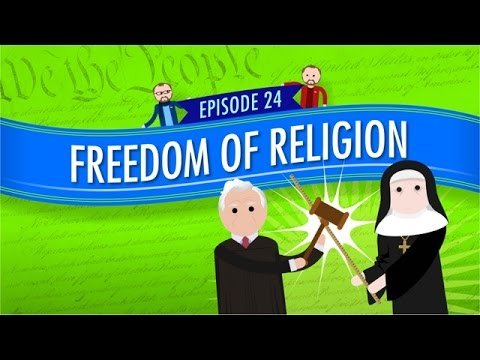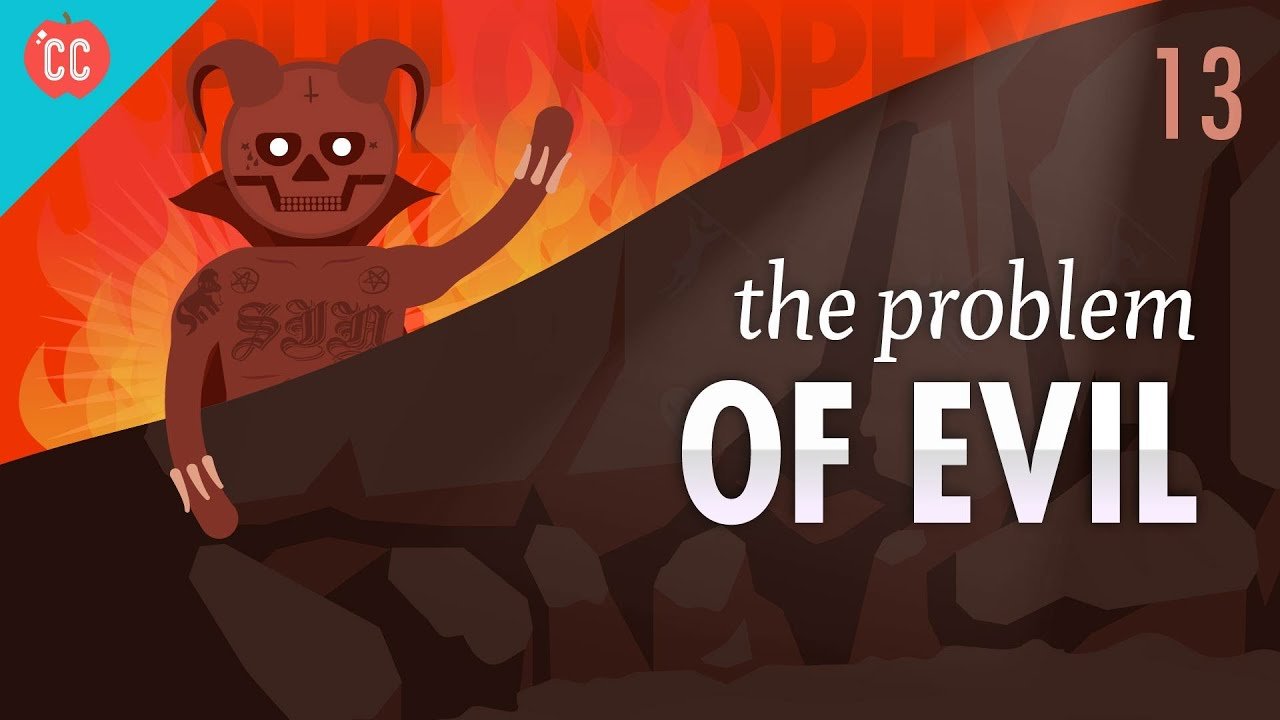Hi, I’m Craig, and this is Crash Course Government and Politics, and I’m excited. I’m excited because today, we start delving into Supreme Court jurisprudence, with the totally controversial topic of freedom of religion. Now, other than being fun to say, jurisprudence means all the important cases on a particular topic, but unfortunately,
I’m only going to be talking about a couple of them, because they demonstrate how the Supreme Court reasons its way through a tricky issue. Jurisprudence. Jurisprudence. [Theme Music] So the Constitution deals with religion right there in the First Amendment, which is also
The one that deals with speech and the press and assembly and petitions. Here’s what it says: “Congress shall make no law respecting an establishment of religion or prohibiting the free exercise thereof.” It’s the first clause in the First Amendment of the Bill
Of Rights, so it’s pretty darn important. Notice it has two parts, and each one creates a separate religious liberty or freedom. The first part, “no law respecting an establishment of religion” is caused the establishment clause; can you guess what the second religious liberty
Is? If you said free exercise, you’re right. What do these two freedoms mean, though? Establishment of religion means that the US can’t create an official state church, like England has with the church of England. This means that the First Amendment ensures that the US
Does not have any state endorsed religion nor does it write its laws based on any religious edicts, and it’s also the clause in the Constitution that deals with religious monuments and school prayers and stuff like that. The free exercise clause in a way is more straightforward, it means you can’t pay for exercise.
Gym memberships are illegal. But freedom isn’t free. You’re gonna pay with pain! No pain, no gain. Actually, none of that is what we’re talking about. What it means is you can’t be prohibited from being part of a certain religion, although it doesn’t
Mean that any religious practice is okay. For example, if your religion requires human sacrifice, because you’re an Aztec, state, local, and federal law could prevent you from practicing that aspect of religion, for obvious reasons, although it couldn’t prevent you from believing that human sacrifices were necessary to make the sun rise every day.
We are gonna anger a lot of Aztecs with this video, Stan. There are a number of cases that establish this distinction between religious belief and religious practice, but my personal favorite is Church of Lukumi Babalu Aye vs. Hialeah,
Because I love saying Lukumi Babalu Aye. You probably figured out that what these two clauses mean in practice has been determined to some degree by Supreme Court decisions. There’s a bunch of them, but probably the most important one is called Lemon v. Kurtzman, from 1971.
Right off the bat, the Lemon decision is a little complicated because it combines two sets of facts, although they both involve public money and parochial schools. In one case in Rhode Island, the state was using taxpayer funds to pay teachers in parochial
Schools in an effort to educate Rhode Island children, which is generally a good goal. In the other case in Pennsylvania, the state was paying teachers in private schools to provide secular education services, but enough with the set-up, let’s go to the Thought Bubble.
The Supreme Court in Lemon vs. Kurtzman devised a three prong test to see if the state law violates the First Amendment religious freedom clauses. Under the first prong, the Court looks to see whether the law in question has a secular legislative purpose. In this case,
The purpose of the law was educating children, which you remember, is one of the powers reserved to the states, and for the most part, is a secular purpose. Under the second prong, the Court examines whether or not the law’s principal or primary
Effect neither enhances nor inhibits religion. Here again, the Court found that paying private school teachers or using private school facilities did not necessarily promote religion or prevent students from worshipping as they wanted to. The third prong requires that the law under consideration does not create excessive entanglement
Between a church and the state. This is the one where both the Rhode Island and Pennsylvania laws got into trouble. In Rhode Island, the school buildings where the children were learning were full of religious imagery, and 2/3 of the teachers were nuns. The Court paid close
Attention the fact that the people involved were kids, ruling, “This process of inculcating religious doctrine is, of course, enhanced by the impressionable age of the pupils in primary schools particularly. In short, parochial schools involve substantial religious activity and purpose.” In Pennsylvania, the problem was different. The Court ruled that in order
To make sure that the teachers were NOT teaching religion, the state would have to monitor them so closely that it would be excessive entanglement and give the state way too much control. They ruled that, “The very restrictions in surveillance necessary to ensure that teachers
Play a strictly non-ideological role give rise to entanglements between church and state.” Thanks, Thought Bubble. So it’s pretty complicated, and I’m not 100% sure that I find it convincing. First of all, the Justices engaged in some slippery slope reasoning about the Pennsylvania case.
The Court argued that even if, in this situation, the secular purpose was a good one, there’s a tendency for states to take more and more power for themselves. But my bigger concern is that all three prongs in this case were given equal weight, and I’m not sure that
They always should be. I mean, you got the one round one and then the two like, you know, long ones, and you can pull that round one, it’s just for grounding. What the ruling in this case meant was that the secular purpose, educating children, was
Not gonna happen, or at least would be made more difficult. Also, you could argue that it was kind of paternalistic, assuming that kids wouldn’t be able to block out religious imagery, but since they are kids, maybe a little paternalism is okay. You spit that gum out, Junior.
So Lemon vs. Kurtzman built on an earlier case, Engel vs. Vitale, which ruled that prayer in schools violated religious freedom. You would think that, taken together, this issue would be pretty much put to bed, yet every few years, a case comes along involving prayer
In school, and now they apply the old three prong Lemon test. For example, one state adopted a statute mandating a moment of silence at the beginning of each school day. One of the purposes of this statute is to provide students with an opportunity to pray in school. Another
Purpose is to create a calming atmosphere in the classroom to better promote learning. The first purpose doesn’t look so secular, and as for the second prong, doesn’t necessarily advance or inhibit a particular religion. Students can choose not to pray at all. Is
This excessive entanglement? That’s always gonna be difficult to say, especially since ‘excessive’ is pretty subjective, but if you go on the standard of the Pennsylvania case in Lemon, almost any religious practice in school could be excessively entangling, because the state is going to have to step in and monitor it.
Some school systems have tried to get around this by having the prayers led by students, because they aren’t agents of the state. But then you have the issue of how much a student-led prayer is really led by a student, and how do you find out without more monitoring and
More state entanglement? The Lemon test is an attempt by the Court to set up a framework for analyzing future situations where religion and the state might get mixed up. It’s probably better than having what legal scholars like to call “a bright line rule” about religion
In public spaces like schools and courthouses, but it does leave a lot of wiggle room and it seems that it encourages future cases because we keep seeing them. The funny thing is, religious freedom is one of the less controversial protections found in the First Amendment, if you don’t
Believe me, wait until our next episode on free speech. Just wait. You just — you just wait. Did you guys hear what he said? See ya next time. Crash Course Government and Politics is produced in association with PBS Digital Studios. Support
For Crash Course US Government comes from Voqal. Voqal supports non-profits that use technology and media to advance social equity. Learn more about their mission and initiatives at voqal.org. Crash Course was made with the help of all these jurisprudences, am I using that word right? Thanks for watching.
#Freedom #Religion #Crash #Government #Politics


